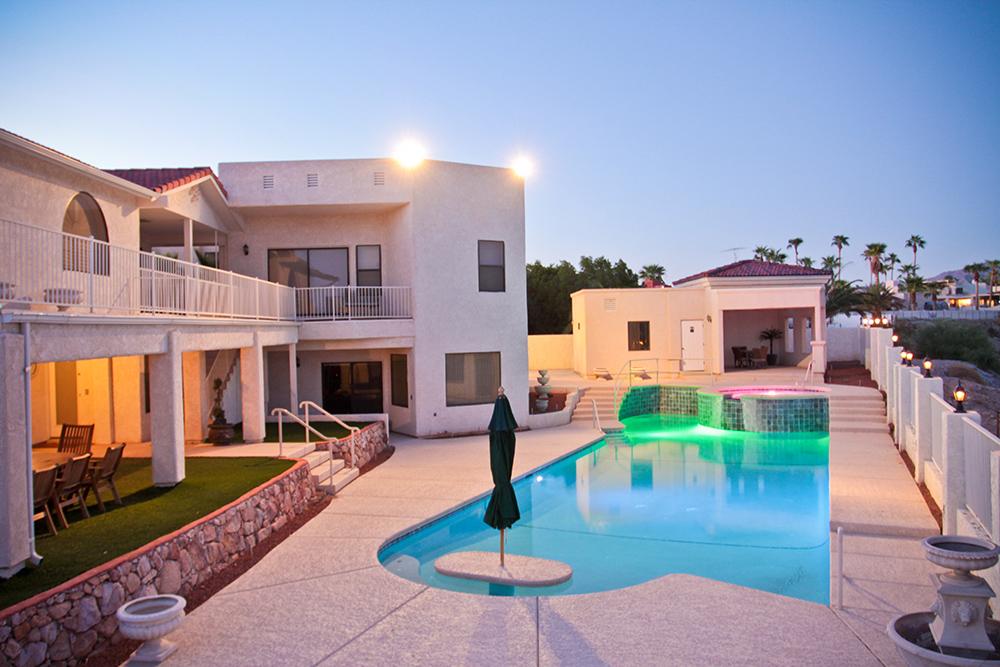Have you ever driven home at night and had to deal with driving through water running down the street? If you’re new to Lake Havasu, please know that it is a common phenomenon that occurs quite frequently in the evening. No, it’s not a pipe break or a sudden rainstorm, but rather one of your neighbors draining their swimming pool.
Why in the evening? Well, we’re glad you asked! There are a lot of myths around town about when and where you can drain your swimming pool. Rather than rehash the fallacies pertaining to pool emptying, we thought we’d go to the source and check with Lake Havasu City’s Code Enforcement Agency.
According to the city website at www.lhcaz.gov, swimming pools can be drained in the street between 8 p.m. and 6 a.m., seven days a week. In an emergency situation, pools can be drained during the day, but the city needs to be notified of the event.
Another question frequently asked is if pools can be drained into our local washes, and the answer is yes. As long as the water drained into the wash isn’t going to cause a major flow of water across a roadway, a swimming pool can be drained into a wash. Many backyards with pools back up against a wash and this is a convenient way to discharge a swimming pool. Furthermore, according to code enforcement, pools that are drained into a wash can be done any time of day.
So, the next time you’re driving home in the evening and run into a steady stream of water down the roadway, don’t worry, it’s just another pool being drained in preparation for another pool season. In fact, most pools are drained and refilled this time of year in preparation for our extended summer swimming season.
Many residents have a misunderstanding when it comes to the costs involved with draining and filling a swimming pool. Since our monthly sewer rates are calculated to our water consumption, homeowners may think that their sewer and water bill will increase drastically. After all, the average swimming pool in Lake Havasu contains between 1,500 and 2,000 cubic feet of water.
The reality is that you can read your meter (much like reading your car odometer), which can be found on your water main leading into your home, and record the amount of water before and after filling your pool. Reporting that to the city will allow them to make the adjustment so it will not affect your sewer rate. All you have to pay for is the additional water, and for an average pool fill-up, that means an average of a one-time addition to your water bill of $30-$45.
Many people wonder why they have to drain their pool. After all, at a quick glance, a pool can look sparkling clean, inviting, and refreshing, but the reality can be quite different. Checking with a pool specialist who can test your water to determine if your pool needs drained is the best way to go. As a rule of thumb in Lake Havasu, a pool needs to be drained and refilled every 2 or 3 pool seasons.
Now is the ideal time to drain your pool. Waiting until it is too hot out can cause damage to your pool. The major reason to drain a swimming pool is because of the TDS or Total Dissolved Solids present in your pool. The water can only take so much as far as minerals and chemicals placed in it. After time, the water becomes super saturated with the chemicals we use to keep our pool clean causing a chemical imbalance that can damage the pool. If you’ve ever gotten out of your pool and felt itchy all over, you may want to have the water checked. Most people invest in a Modern Pool House with a shower so that they can rinse off any chemicals.
Let’s face it, the water in this area is pretty hard to begin with; when you combine low humidity, wind, and summertime temperatures that reach upwards of 120 degrees, your pool is going to evaporate a lot of water. The problem arises because the water in the pool evaporates, but the total dissolved solids remain. Even fresh water being added to the pool has a certain TDS level. High TDS levels can destroy a pool in a very short period of time. One problem is calcium deposits at the pool’s water line. Also, a high TDS level can cause skin irritation and scratchy eyes. Calcium can be especially damaging to gunite pools, which are common in Lake Havasu.
Pool experts will tell you that the maximum TDS level is 1500 ppm (parts per million), anything lower than that is acceptable with optimum conditions around 1200 ppm. Keeping a pool’s pH and TDS levels in check can guarantee you a healthy and fun backyard swimming season, and it can be as simple a procedure as starting the season out right by draining and refilling your swimming pool.


